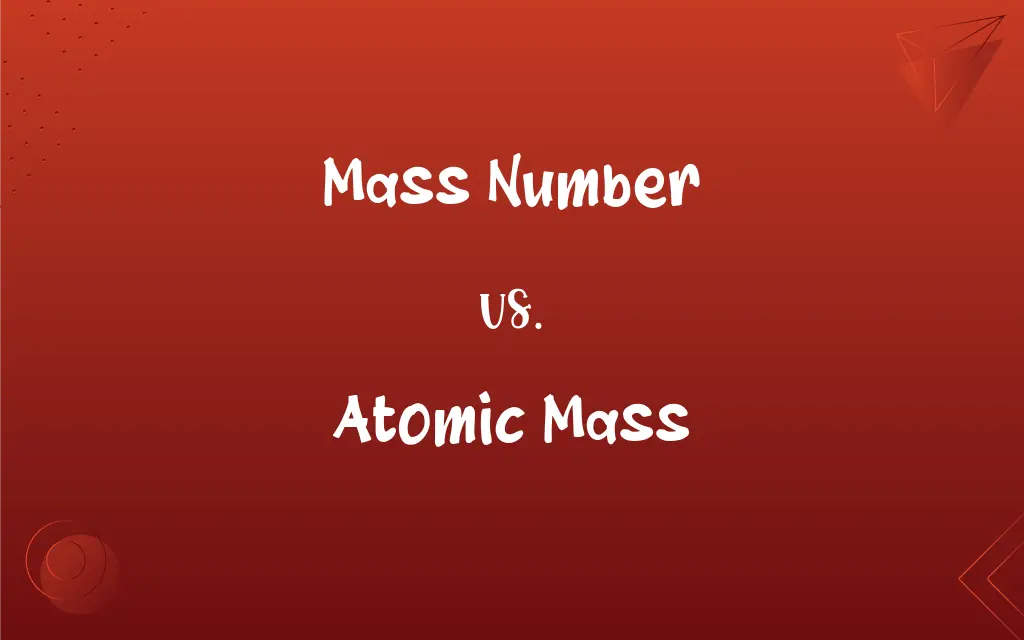Mass Number vs. Atomic Mass: What's the Difference?
Edited by Aimie Carlson || By Janet White || Published on November 30, 2023
Mass number is the total count of protons and neutrons in an atom's nucleus; atomic mass is the average mass of an element's isotopes, weighted by abundance.

Key Differences
The mass number of an atom is a whole number representing the sum of its protons and neutrons. Atomic mass, alternatively, is a decimal value indicating the average mass of all the isotopes of an element, considering their natural abundance.
Mass number provides insight into the specific isotope of an element, defining the composition of its nucleus. Atomic mass reflects the averaged mass of an element’s isotopes as they occur naturally, offering a broader understanding of the element’s physical properties.
For a given element, different isotopes will have different mass numbers due to varying numbers of neutrons, while the atomic number remains constant. Atomic mass, however, takes into account these isotopic variations and their relative abundance in nature.
Mass number is integral in identifying the stability of an isotope and its potential for radioactive decay. Atomic mass is crucial in chemical calculations, such as determining the amount of a substance required for a chemical reaction.
Mass number is specific to each atom, providing a discrete value based on its nuclear composition. In contrast, atomic mass is a standardized value found on the periodic table, representing an average that accounts for all of an element's isotopes.
ADVERTISEMENT
Comparison Chart
Definition
Total count of protons and neutrons in an atom’s nucleus
Weighted average mass of an element’s isotopes
Representation
Whole number
Decimal value
Role
Identifies specific isotopes
Reflects averaged mass considering isotopic abundance
Variation
Different for isotopes of the same element
Constant for each element, varying between different elements
Usage
Determines isotope stability and identity
Used in chemical calculations and standard measurements
ADVERTISEMENT
Mass Number and Atomic Mass Definitions
Mass Number
The total number of protons and neutrons in an atom’s nucleus.
The mass number of carbon-12 is 12, derived from 6 protons and 6 neutrons.
Atomic Mass
A decimal value representing the standard mass of an element.
Hydrogen's atomic mass of about 1.008 accounts for its isotopes' natural occurrence.
Mass Number
A nuclear property defining an atom’s mass characteristics.
The mass number of an iron atom determines its specific isotope.
Atomic Mass
A calculated value for an element's mean isotopic mass.
Chlorine's atomic mass of about 35.45 is based on its two main isotopes.
Mass Number
A specific indicator of an atom’s isotope.
Uranium-235's mass number is 235, indicating its nuclear composition.
Atomic Mass
The average mass of an element’s isotopes, weighted by their abundance.
The atomic mass of carbon is approximately 12.01, reflecting its isotopic distribution.
Mass Number
A whole number representing the sum of an atom's nuclear particles.
An oxygen atom with 8 protons and 8 neutrons has a mass number of 16.
Atomic Mass
A measure of an element’s mass as it naturally occurs.
The atomic mass of nitrogen is 14.007, considering its isotopic composition.
Mass Number
A key factor in identifying atomic species.
The mass number of helium-4 helps distinguish it from other helium isotopes.
Atomic Mass
An element’s averaged isotopic mass found on the periodic table.
Oxygen's atomic mass of 15.999 reflects its most common isotopes.
FAQs
Can the mass number be the same for different elements?
No, it is unique for each isotope of an element.
What is atomic mass?
Atomic mass is the weighted average mass of all an element's isotopes.
Is atomic mass constant for all isotopes of an element?
Yes, atomic mass is a constant average value for an element, irrespective of the isotope.
What determines atomic mass?
The average mass of an element’s isotopes, weighted by their natural abundance.
What is mass number?
It’s the total count of protons and neutrons in an atom's nucleus.
How is mass number calculated?
By adding the number of protons and neutrons in an atom.
How is atomic mass used in chemical reactions?
It’s used to calculate the amount of an element required in a reaction.
How accurate is atomic mass in practical applications?
Quite accurate, especially for calculations in chemistry and physics.
What role does mass number play in chemistry?
It helps in identifying specific isotopes and understanding nuclear properties.
Does atomic mass appear on the periodic table?
Yes, it's the decimal number listed under each element's symbol.
Is atomic mass important for calculating molecular weight?
Absolutely, it's essential for determining the weight of molecules.
Why do isotopes have different mass numbers?
Because they have different numbers of neutrons in their nuclei.
What’s the significance of mass number in radioactive materials?
It helps in identifying specific radioactive isotopes and their properties.
Why is mass number a whole number?
Because it counts the total number of protons and neutrons, which are whole entities.
Is atomic mass relevant in nuclear physics?
Yes, especially in understanding the behavior of different isotopes.
Can mass number vary within an element?
Yes, due to the presence of different isotopes with varying neutron counts.
Do isotopes affect mass number?
Yes, different isotopes of the same element have different mass numbers.
Does mass number indicate the stability of an isotope?
It can give insights into an isotope’s stability and potential for radioactive decay.
Can atomic mass change?
It remains constant for an element but can vary between different elements.
How do mass number and atomic mass differ in use?
Mass number identifies isotopes; atomic mass is used for calculating elemental proportions in compounds.
About Author
Written by
Janet WhiteJanet White has been an esteemed writer and blogger for Difference Wiki. Holding a Master's degree in Science and Medical Journalism from the prestigious Boston University, she has consistently demonstrated her expertise and passion for her field. When she's not immersed in her work, Janet relishes her time exercising, delving into a good book, and cherishing moments with friends and family.
Edited by
Aimie CarlsonAimie Carlson, holding a master's degree in English literature, is a fervent English language enthusiast. She lends her writing talents to Difference Wiki, a prominent website that specializes in comparisons, offering readers insightful analyses that both captivate and inform.








































































